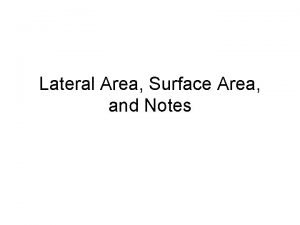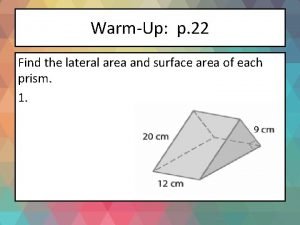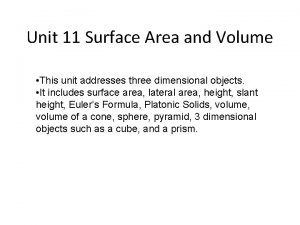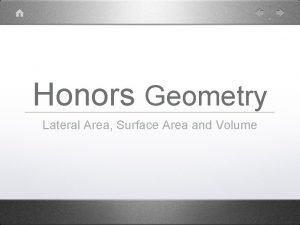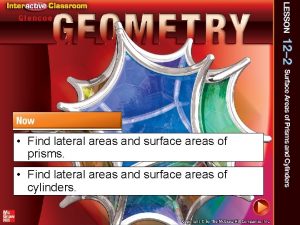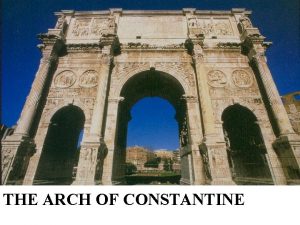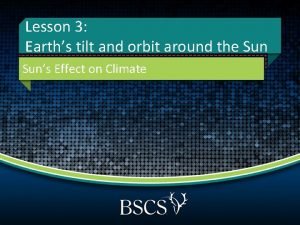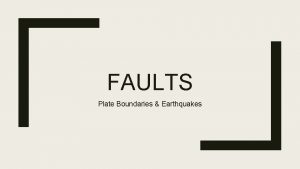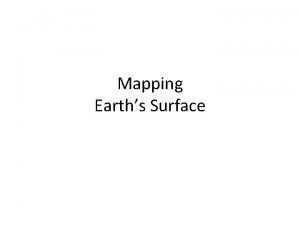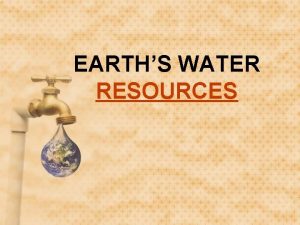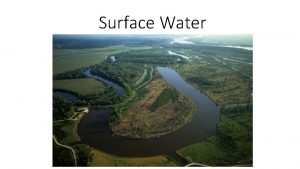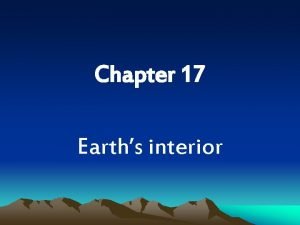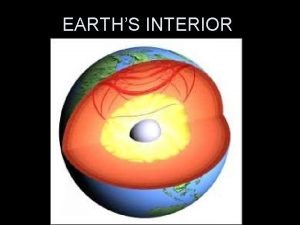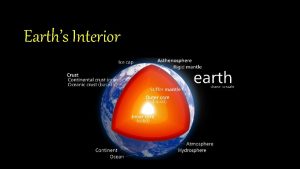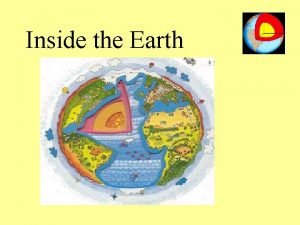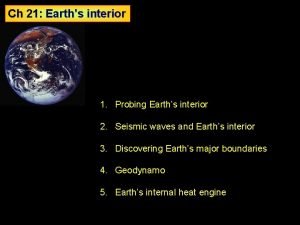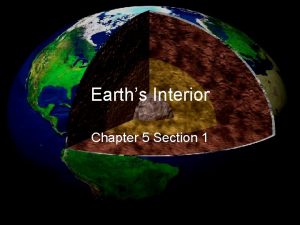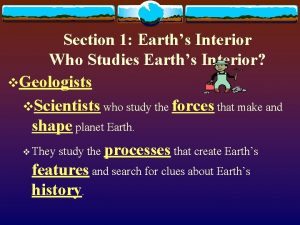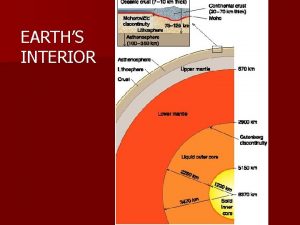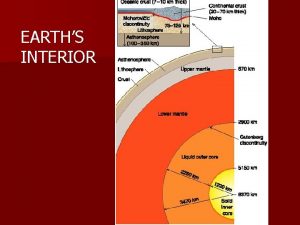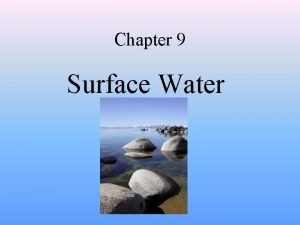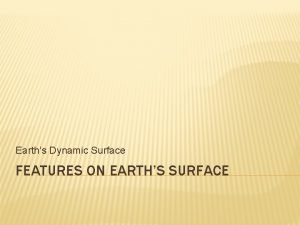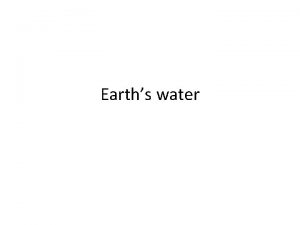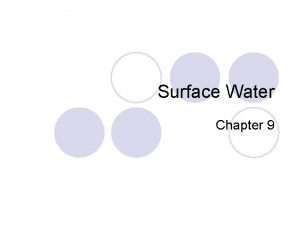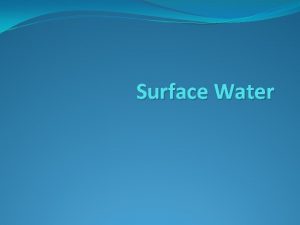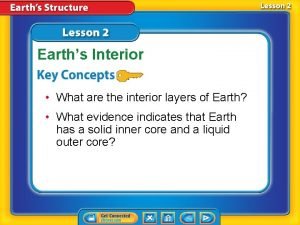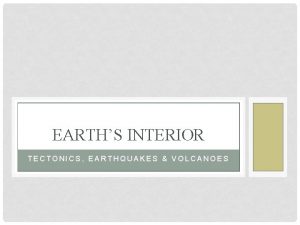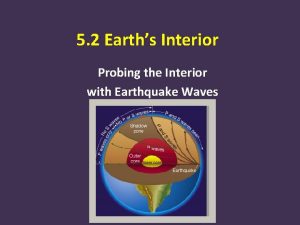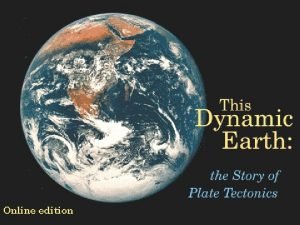Earths Interior 1 Surface area is 71 water




































- Slides: 36

Earth's Interior 1

Surface area is 71% water, 29% continents 2

The Earth - Surface and Interior Basic Data Diameter Mass Density 12, 756 km (equator) 6 x 1024 kg 5. 5 g/cm 3 5500 kg/m 3 Escape velocity 11. 2 km/s Surf. Temperature 183 K to 333 K Albedo 0. 31 (= fraction of incoming sunlight that a planet reflects) 3

Densities of typical surface rocks: 3000 kg/m 3 Average density of Earth as a whole (its mass/volume): 5500 kg/m 3 Interior must be much denser than the crust! How can we probe the interior? 4

Seismology • Study of earthquakes and seismic waves that move through and around the Earth • Primary and Secondary wave move through the Earth. Love and Rayleigh waves move around surface. 5

• P waves – “primary”, pressure or longitudinal. Fastest waves. Can pass through liquid. S waves – “secondary”, shear or transverse. Cannot travel far in liquid • 6

• Love waves - surface waves moving ground side-to-side • Rayleigh waves - surface waves rolling the ground (up-down, back-forward) 7

Refraction of seismic waves stiffer rock v 2>v 1 v 1>v 2 Also get reflected wave component at a sharp boundary, angle of incidence = angle of reflection In general, velocity depends on resistance to compression or shear (which depends on pressure, composition, phase), divided by density. In mantle, for example, velocity increases steadily with depth, wave paths curve. 8

Location and timing of P and S waves measured around the surface reveal interior structure: thin crust, mantle, and core. Shadow zone with no Swaves: the Earth must have a liquid core! Also fairly sharp density increase when you hit the core. Later, faint P waves found in part of shadow zone – solid inner core inferred. Velocity drops at mantle-core boundary. Molten core has lower rigidity than mantle. Refracted components bend away from interface Velocity increases at outer core-inner core boundary. Inner core has higher rigidity. Reflected component seen in “weak P-waves” zone. Refracted component in “P-waves only” zone. 9

Layered structure of interior: 1. central very dense core of almost pure iron, 2. surrounded by mantle of dense, iron-rich minerals (also magnesium, silicon), 3. surrounded by crust of relatively light silicon-rich minerals. (You are here. ) Earth is differentiated. 10

Young Earth must have been molten, allowing denser materials like iron to sink to center, while less-dense minerals rose toward surface. Differentiation seen in rocky bodies throughout the Solar System! 11

Note: mantle is solid, but upper levels are “plastic”, acts like a very thick, or viscous fluid. Can flow slowly. Even solid rock can deform like a plastic if subject to stresses. Important for next topic… 12

Yellow curve is temperature, red curve is melting point of Earth’s material at these levels, and depends on pressure. Pressure increases with increasing depth. 13

Plate tectonics Plates 10 -50 km thick, extend into upper mantle Plate motion ~ a few cm/year. Directly measurable 14

Other indications of tectonic motions • Shapes of plates seem to fit with each other • Fossils indicate earlier joining of continents • Volcanic, seismic and geothermal activity 15

Plate tectonics • Solid plates float on plastic upper mantle • Why? Convection. Earth interior is hot and still cooling off! Aesthenosphere is flowing, soft upper layer of the mantle Lithosphere is rigid layer of crust and top of mantle Convection timescale about 100 million years for plate tectonics 16 Why is Earth so hot?

Origin of internal heat driving plate tectonics 1. Original heat of colliding planetesimals which formed Earth - Earth hasn't cooled off completely (gravitational energy). 2. Radioactive decay of elements in Earth, such as uranium, thorium and potassium. 17

Continental drift http: //www. ucmp. berkeley. edu/geology/anim 1. html 18

Divergent plate boundaries Where plates separate, get rift. Most rifts zones are in oceans. (Though not all – Rio Grande rift!) Mid-Atlantic Ridge is an oceanic rift New rock forms as lava seeps up from Earth’s interior. 19

Convergent plate boundaries Where continental plates collide head-on, mountains are built. Here, the Indian plate and Eurasian plate are colliding to form the Himalayas. 20

Convergent plate boundaries Where one plate slides underneath another, (called a subduction zone) volcanoes are common - here, on boundary of Pacific and Eurasian plates. Where one plate goes under, material is “recycled” back into the mantle. 21

Transform boundaries When plates slide past each other. Example: North American and Pacific plates are carrying Los Angeles and San Francisco toward each other. LA will be suburb of SF in about 25 million years! Source of strong near-surface Earthquakes (e. g. 1906 San Francisco) 22

Hot spots Located in the middle of the plates: Plumes of magma from plate/mantle transition wells up. Hot spot fixed => chain of volcanoes Example: Hawaii. Picture from space shuttle Discovery, 1988 23

The dynamic Earth • Surface is shaped and reshaped over billions of years (plate tectonics, wind, erosion) • Most of the surface is young (10 -100 Myr) • Active today (interior still molten and hot, now 80% of the crustal heat from radioactive decay) 24

Impact craters exist but are wiped out by wind and water erosion and plate tectonics. Meteor Crater, AZ 25

Future consequences • Portions of California will separate from the rest of North America. • The Italian "boot" will disappear. • Australia will become linked to Asia. • Africa will separate from the Near East. 26

27

Earth's surface • 71% water • Rocks – solids containing one or more minerals. Example 1: feldspar (potassium, aluminum, silicon, oxygen). Example 2: granite contains feldspar and quartz (mineral containing silicon and oxygen). Geologic process create three major categories of rocks: 28

Igneous: rock cooled from molten state. Basalt, mixture of feldspar and iron-rich minerals, is most common. Ocean floor is mostly basalt. 29

Sedimentary: compressed layers of sand or soil, produced by wind, water, or ice, cemented by other minerals. Examples: sandstone (shown), limestone. Often created on ocean floors. 30

These sedimentary rocks are in the Rockies. How did they get there? ? ? 31

Metamorphic: produced when igneous or sedimentary rocks are buried beneath surface, and subjected to great heat and pressure. Examples: marble, schist. Tectonic activity sometimes lifts up material from deep within the crust. Often found in mountain ranges. 32

Notes • Interested in geology? This Dynamic Earth (Kious & Tilling) http: //pubs. usgs. gov/gip/dynamic. html • Next time: magnetic fields and earth's atmosphere (rest of chapter 9). 33

34

35

If the surface if mostly water, why is the albedo so high? 36
 Earths interior
Earths interior Surface area vs area
Surface area vs area Volume and surface area of cone
Volume and surface area of cone Water and water and water water
Water and water and water water Lateral area def
Lateral area def Area vs surface area
Area vs surface area Lateral edge
Lateral edge Latwral area
Latwral area Lateral area vs surface area
Lateral area vs surface area How to find the lateral area of a hexagonal prism
How to find the lateral area of a hexagonal prism Earth layers foldable
Earth layers foldable Earths roation
Earths roation Whats earths moon called
Whats earths moon called Home sweet biome crossword
Home sweet biome crossword What is the most abundant element on earth
What is the most abundant element on earth Plasticity in earth's layers
Plasticity in earth's layers Whats earths moon called
Whats earths moon called Whats the thickest layer of the earth
Whats the thickest layer of the earth Earths early atmosphere contained
Earths early atmosphere contained Is lithosphere part of the crust
Is lithosphere part of the crust Earths major crustal plates
Earths major crustal plates Earths orbit seasons
Earths orbit seasons Brown earth soil ireland
Brown earth soil ireland Earths physical features
Earths physical features Earths honey
Earths honey What is luna moon
What is luna moon Pangea explanation
Pangea explanation Earths crust
Earths crust What does the earths tilt cause
What does the earths tilt cause Atmosphere
Atmosphere What is this shape
What is this shape Arch of constantine frieze
Arch of constantine frieze What does earths tilt do
What does earths tilt do Earths boundaries
Earths boundaries Earths 4 spheres
Earths 4 spheres High surface tension vs low surface tension
High surface tension vs low surface tension Surface area of a circle
Surface area of a circle




